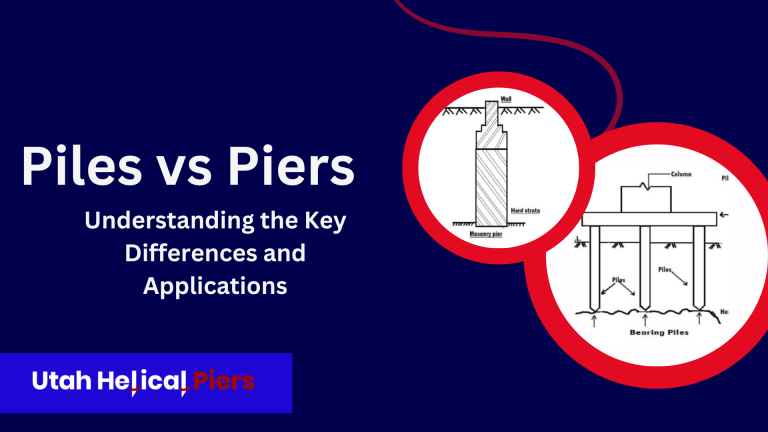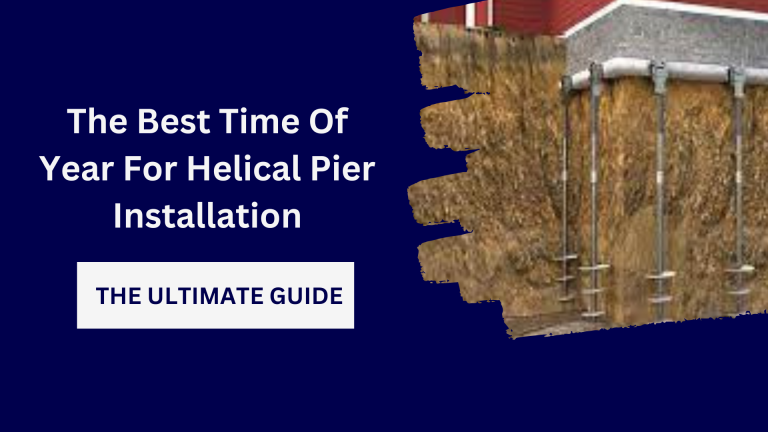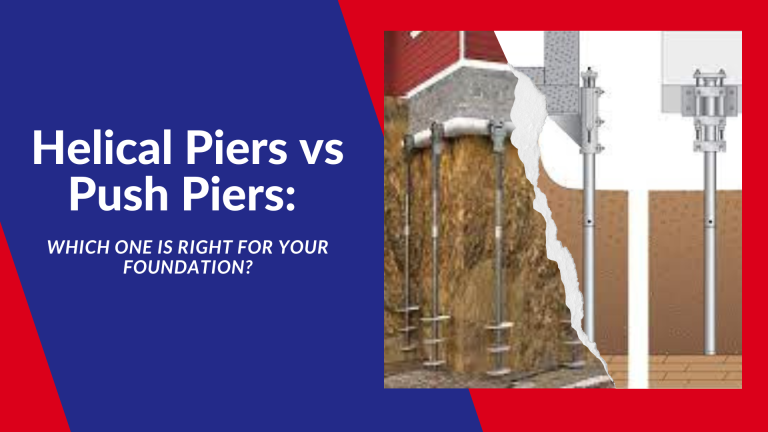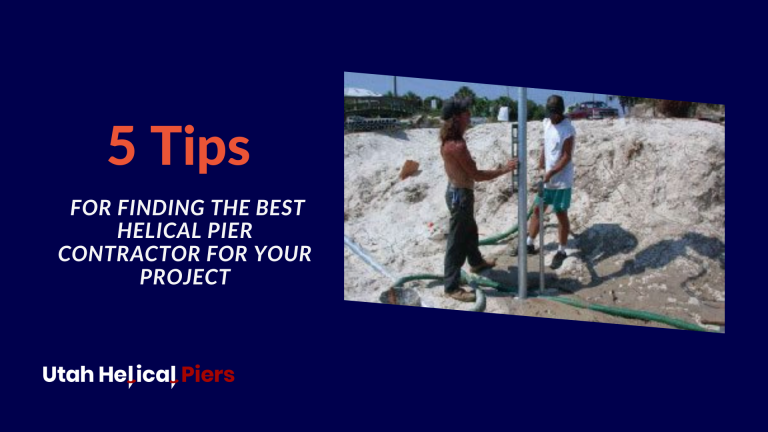A strong foundation is essential to the stability of any building, and when it comes to foundation repair, helical piers are the ultimate solution.
They have become increasingly popular in recent years due to their many advantages over traditional foundation repair methods. Helical piers are an innovative technology that can be used to fix a wide range of foundation issues, including settling, sinking, and shifting.
They are designed to provide a secure and long-lasting foundation for any type of structure, from residential homes to commercial buildings.
In this article, we will explore the top reasons why helical piers are the ultimate foundation repair solution and why they are a popular choice among homeowners and contractors alike.
Whether you are dealing with foundation issues or simply curious about the latest foundation repair technology, this article will provide you with valuable insights into the benefits of helical piers.
Understanding the need for foundation repair
A building’s foundation is the most important part of its structure. It supports the entire weight of the building and ensures that it remains stable and secure.
However, over time, the foundation can experience various issues that can compromise its structural integrity. Some of the most common signs of foundation problems include cracks in the walls, uneven floors, and doors that won’t close properly.
If these issues are left untreated, they can worsen over time and lead to more serious problems, such as structural damage and even collapse.
Traditional foundation repair methods
In the past, traditional foundation repair methods involved excavating the soil around the foundation and installing concrete piers or footings.
This process, although widely used, had its drawbacks and limitations. The excavation itself was a laborious and time-consuming task, requiring significant manual effort or the use of heavy machinery.
Not only did this prolong the repair timeline, but it also added to the overall cost of the project.
One of the major concerns with traditional methods was the potential damage they could cause to the surrounding landscape.
Heavy machinery used for excavation and lifting heavy concrete materials often left a noticeable impact, disturbing the aesthetics of the property.
The process required careful planning to avoid disrupting nearby plants, trees, or hardscaping elements.
Moreover, despite their extensive efforts, traditional foundation repair methods did not always provide a foolproof solution for preventing future foundation issues.
Factors such as soil movement, settling, or changes in the groundwater table could still lead to subsequent problems. Homeowners often found themselves in a cycle of recurring foundation repairs, requiring them to invest more time and money into maintaining the stability of their structures.
Recognizing the limitations of traditional methods, advancements in foundation repair techniques have emerged in recent years.
These modern approaches aim to address the shortcomings of the past and offer more efficient, cost-effective, and long-lasting solutions for foundation repairs.
What are helical piers?
Helical piers are a type of foundation support system that uses steel shafts with helical blades to anchor the foundation to solid bedrock or load-bearing soil.
The helical blades are designed to screw into the ground, creating a stable and secure foundation for the building.
Helical piers can be installed in a variety of soil conditions, including soft soil, clay, and sand. They are also ideal for areas with limited access, as they can be installed using small equipment.
Benefits of helical piers
Helical piers offer numerous advantages when it comes to foundation repair. Their unique design and features make them a reliable and efficient solution for addressing various foundation issues. Here are some key benefits of using helical piers:
Long-lasting Foundation Solution:
Helical piers excel in providing a durable foundation solution. They are specifically designed to support the weight of the building and prevent settling or shifting over time. By securely anchoring into stable soil layers, helical piers ensure the stability and integrity of the foundation for years to come.
Corrosion Resistance and Weather Resilience:
One notable advantage of helical piers is their resistance to corrosion. Made from high-quality materials, such as galvanized steel, they are built to withstand even the harshest weather conditions. This ensures that the foundation remains strong and stable, regardless of environmental factors.
Eco-friendly and Less Invasive:
Helical piers offer an eco-friendly alternative to traditional foundation repair methods. They require minimal excavation compared to other techniques, which helps to preserve the surrounding landscape. This less invasive approach minimizes disruption to plants, trees, and other elements of the property while still providing an effective solution.
Versatility in Foundation Repair:
Helical piers are highly versatile and can address various foundation issues. Whether it’s settling, sinking, or shifting, helical piers can effectively stabilize the foundation and restore its structural integrity. Moreover, they are equally suitable for new construction projects, providing a quick and hassle-free installation process.
Foundation Underpinning:
In addition to repair purposes, helical piers can also be used for foundation underpinning. This process involves reinforcing the existing foundation of a building to prevent future issues. By strategically placing helical piers to support weak areas, they add strength and stability, significantly reducing the risk of further damage.
The installation process
The installation process for helical piers is characterized by its simplicity, speed, and non-invasiveness. Here’s a step-by-step guide outlining the installation procedure:
Site Preparation:
The process begins with the excavation of a small hole at the base of the foundation. The size of the hole is determined based on the specific requirements of the project and the depth needed to reach the load-bearing soil layers. The excavation is typically done using specialized equipment, ensuring minimal disturbance to the surrounding area.
Helical Pier Insertion:
Once the hole is prepared, the helical pier is carefully inserted into the hole. The pier consists of a shaft with helical plates or blades that resemble large screws. These helical plates enable the pier to be screwed into the ground with rotational force. As the pier is turned, it gradually advances into the soil.
Anchoring to Load-Bearing Soil:
The helical pier continues to be screwed into the ground until it reaches the load-bearing soil or a predetermined depth that ensures stability. The load-bearing soil provides the necessary support for the foundation. The installation process takes advantage of this soil layer to secure the helical pier firmly in place.
Bracket Attachment:
Once the helical pier is securely embedded, a bracket is attached to the foundation. The bracket is designed to connect the foundation to the helical pier. It serves as the intermediary element that transfers the weight of the building onto the pier, relieving the foundation from the stress and pressure it previously endured.
Load Transfer:
With the bracket in place, the weight of the building is gradually transferred from the foundation to the helical pier. This load transfer redistributes the structural burden, allowing the foundation to regain stability and preventing further settling or shifting.
Minimal Disruption:
One of the key advantages of helical pier installation is its non-invasiveness. The process does not involve extensive excavation or disruptive construction methods. This means that the installation can be completed relatively quickly, causing minimal disturbance to the surrounding landscape or occupants of the building.
Overall, the installation process for helical piers is a straightforward and efficient solution for foundation repair. By combining excavation, helical pier insertion, bracket attachment, and load transfer, this method provides a reliable and non-invasive way to stabilize foundations and ensure the long-term integrity of buildings.
How helical piers prevent further foundation damage
Helical piers are designed to prevent future foundation damage by providing a stable and secure foundation for the building. By anchoring the foundation to load-bearing soil or bedrock, helical piers prevent the foundation from settling, sinking, or shifting. This helps to prevent cracks in the walls, uneven floors, and other signs of foundation problems. Additionally, helical piers are resistant to corrosion and can withstand harsh weather conditions, which helps to ensure the long-term stability of the foundation.
Comparing helical piers to other foundation repair solutions
There are many different types of foundation repair solutions available, each with its own set of advantages and disadvantages. Some of the most common foundation repair methods include concrete piers, steel piers, and mudjacking. While these methods can be effective in certain situations, they often require more excavation and can be more expensive than helical piers. Additionally, these methods may not be as versatile as helical piers and may not be suitable for all types of soil conditions.
Cost-effectiveness of helical piers
When it comes to foundation repair, cost is always a consideration. While helical piers may initially seem more expensive than traditional foundation repair methods, they are often more cost-effective in the long run. This is because helical piers provide a long-lasting foundation solution that requires minimal maintenance. Additionally, helical piers are an eco-friendly solution that requires less excavation than traditional foundation repair methods, which can help to reduce costs.
Choosing the right foundation repair contractor
When choosing a foundation repair contractor, it is important to do your research and choose a contractor with experience in helical pier installation. Look for a contractor who is licensed and insured and has a proven track record of success. Additionally, ask for references and read online reviews to ensure that the contractor has a good reputation.
Conclusion
In conclusion, helical piers are the ultimate foundation repair solution for a variety of reasons. They provide a long-lasting and eco-friendly foundation solution that can be used to repair a wide range of foundation issues. Additionally, helical piers are versatile, cost-effective, and easy to install. If you are experiencing foundation problems, consider contacting a foundation repair contractor who specializes in helical pier installation. With the right contractor and the right foundation repair solution, you can ensure the long-term stability and safety of your building.





